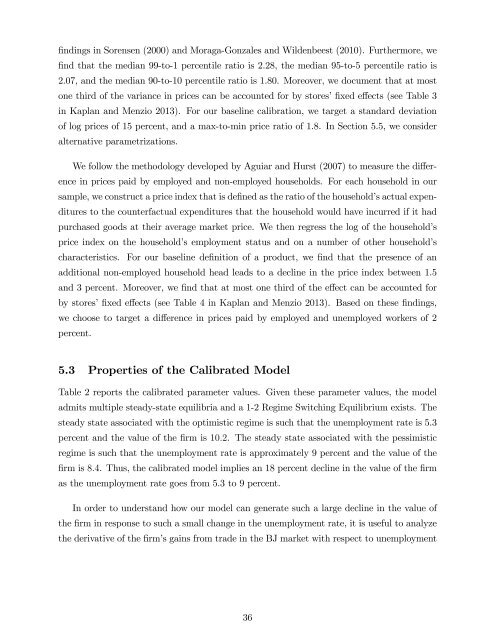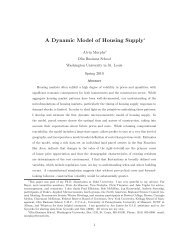Shopping Externalities and Self Fulfilling Unemployment Fluctuations*
Shopping Externalities and Self Fulfilling Unemployment Fluctuations*
Shopping Externalities and Self Fulfilling Unemployment Fluctuations*
Create successful ePaper yourself
Turn your PDF publications into a flip-book with our unique Google optimized e-Paper software.
…ndings in Sorensen (2000) <strong>and</strong> Moraga-Gonzales <strong>and</strong> Wildenbeest (2010). Furthermore, we…nd that the median 99-to-1 percentile ratio is 2.28, the median 95-to-5 percentile ratio is2.07, <strong>and</strong> the median 90-to-10 percentile ratio is 1.80. Moreover, we document that at mostone third of the variance in prices can be accounted for by stores’…xed e¤ects (see Table 3in Kaplan <strong>and</strong> Menzio 2013). For our baseline calibration, we target a st<strong>and</strong>ard deviationof log prices of 15 percent, <strong>and</strong> a max-to-min price ratio of 1.8. In Section 5.5, we consideralternative parametrizations.We follow the methodology developed by Aguiar <strong>and</strong> Hurst (2007) to measure the di¤erencein prices paid by employed <strong>and</strong> non-employed households. For each household in oursample, we construct a price index that is de…ned as the ratio of the household’s actual expendituresto the counterfactual expenditures that the household would have incurred if it hadpurchased goods at their average market price. We then regress the log of the household’sprice index on the household’s employment status <strong>and</strong> on a number of other household’scharacteristics. For our baseline de…nition of a product, we …nd that the presence of anadditional non-employed household head leads to a decline in the price index between 1.5<strong>and</strong> 3 percent. Moreover, we …nd that at most one third of the e¤ect can be accounted forby stores’…xed e¤ects (see Table 4 in Kaplan <strong>and</strong> Menzio 2013). Based on these …ndings,we choose to target a di¤erence in prices paid by employed <strong>and</strong> unemployed workers of 2percent.5.3 Properties of the Calibrated ModelTable 2 reports the calibrated parameter values. Given these parameter values, the modeladmits multiple steady-state equilibria <strong>and</strong> a 1-2 Regime Switching Equilibrium exists. Thesteady state associated with the optimistic regime is such that the unemployment rate is 5.3percent <strong>and</strong> the value of the …rm is 10:2. The steady state associated with the pessimisticregime is such that the unemployment rate is approximately 9 percent <strong>and</strong> the value of the…rm is 8:4. Thus, the calibrated model implies an 18 percent decline in the value of the …rmas the unemployment rate goes from 5.3 to 9 percent.In order to underst<strong>and</strong> how our model can generate such a large decline in the value ofthe …rm in response to such a small change in the unemployment rate, it is useful to analyzethe derivative of the …rm’s gains from trade in the BJ market with respect to unemployment36
















